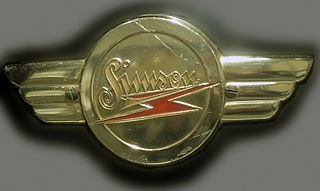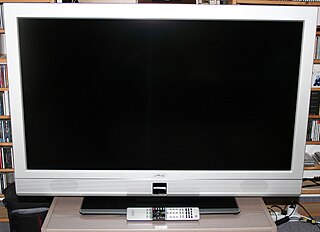
Allgemeine Elektricitäts-Gesellschaft AG was a German producer of electrical equipment. It was founded in 1883 by Emil Rathenau as the Deutsche Edison-Gesellschaft für angewandte Elektricität in Berlin.

ReVox is a brand name, registered by Studer on 27 March 1951 for Swiss audio equipment.

Simson was a German company which produced firearms, automobiles, bicycles and motorcycles, and mopeds. Under the Third Reich, the factory was taken from the Jewish Simson family, and was renamed several times under Nazi and later Communist control. The Simson name was reintroduced as a brand name for mopeds produced at the factory in the German Democratic Republic (GDR). Simson mopeds were then produced in Suhl (Germany) until 2002.

Magnetophon was the brand or model name of the pioneering reel-to-reel tape recorder developed by engineers of the German electronics company AEG in the 1930s, based on the magnetic tape invention by Fritz Pfleumer. AEG created the world's first practical tape recorder, the K1, first demonstrated in Germany in 1935 at the Berlin Radio Show.

Metz-Werke GmbH & Co. KG was a German consumer electronic manufacturer, Besides Loewe and TechniSat, Metz was the only remaining TV manufacturer which developed and produced their devices in Germany. Its head office is in Zirndorf, Bavaria. The company filed for insolvency in 2014 and backed up by new investors now reformed as two independent companies Metz Consumer Electronics GmbH and Metz mecatech GmbH since 2015.
Uher was a German brand of electronic equipment currently owned and licensed by Assmann Electronics of Bad Homburg.

The MRB Z 1013 was an East German single-board computer produced by VEB Robotron Riesa, which was primarily intended for private use and educational institutions. It was powered by a U880 processor and sold together with a membrane keyboard. Initially, the kit was equipped with 16 kilobytes of DRAM, which was later replaced by a 64 KB version.

The Treptowers is a complex of buildings with a distinctive high-rise in the Alt-Treptow district of Berlin, Germany. Completed in 1998, the complex is located on the river Spree. The name "Treptowers" is a portmanteau word from Treptow and the English word "tower".

Industriewerke Ludwigsfelde is an automotive factory in Ludwigsfelde in Brandenburg, just south of Berlin in Germany. The factory is part of Daimler AG and since 1991 it has made Mercedes-Benz vans. It is also the producer of the Multicar line of automobiles.

Gábor Kornél Tolnai was a Hungarian-Swedish engineer and inventor. He is best known for his inventions and patents for spinning machines, devices for the Swedish National Defense and several types of tape recorders.

The Berlin Stalin statue was a bronze portrayal of the Soviet leader Joseph Stalin. A Komsomol delegation had presented the sculpture to the East Berlin government on the occasion of the Third World Festival of Youth and Students in 1951. The monument was formally dedicated on 3 August 1951 after temporary placement at a location on a newly designed and impressive boulevard, Stalinallee, being constructed at the time in what was then the Berlin district of Friedrichshain. Stalin monuments were generally removed from public view by the leadership of the Soviet Union and other associated countries, including East Germany, during the period of De-Stalinization. In Berlin the statue and all street signs designating Stalinallee were hastily removed one night in a clandestine operation and the street was renamed Karl-Marx-Allee and Frankfurter Allee. The bronze sculpture was smashed and the pieces were recycled.
Buna Werke Schkopau were a chemical company specialising in the production of polymer materials such as plastics and artificial rubber. The name BUNA is derived from the technology of polymerising butadiene with sodium as a catalyst.

The P8000 is a microcomputer system developed in 1987 by the VEB Elektro-Apparate-Werke Berlin-Treptow „Friedrich Ebert“ (EAW) in the German Democratic Republic. It consisted of an 8-bit and a 16-bit microprocessor and a Winchester disk controller. It was intended as a universal programming and development system for multi-user/multi-task applications. The initial list price of the P8000 was 172,125 East German marks.

VEB Kombinat Mikroelektronik Erfurt was an important manufacturer of active electronic components in East Germany. It should not be confused with the more well-known VEB Kombinat Robotron Dresden which used integrated circuits from Kombinat Mikroelektronik in its computers.
The Z80 Operating System with Relocatable Modules and I/O Management (Z80-RIO) is a general-purpose operating system developed by Zilog in the late 1970s for various computer systems including the Z80 Micro Computer System (MCZ-1) series and the Z80 Development System (ZDS). The MCZ systems were primarily used for software development and automation solutions. RIO was designed to facilitate the development and integration of user's programs into a production environment.

The educational computer LC80 was a single-board computer manufactured in the German Democratic Republic (GDR) and intended for teaching purposes. It was the first computer that retail customers could buy in the GDR.

Eberhard Rebling was a German pianist, musicologist and dance scholar as well as an anti fascist.

Lodewijk Frederik Ottens was a Dutch engineer and inventor, best known as the inventor of the cassette tape, and for his work in helping to develop the compact disc. Ottens was employed by Philips for the entirety of his career.
Joachim Werzlau was a German pianist, radio consultant and composer. He belonged to the first generation of composers in the GDR, where he was also active in organisations and politics. As a pianist, he played for the theatre, for Mary Wigman's dance school, and a kabarett, among others. He composed popular songs, music for audio plays, film scores, incidental music, and three operas. With films such as Nackt unter Wölfen and Jakob der Lügner, he was the most popular film composer of the GDR of his time.

















